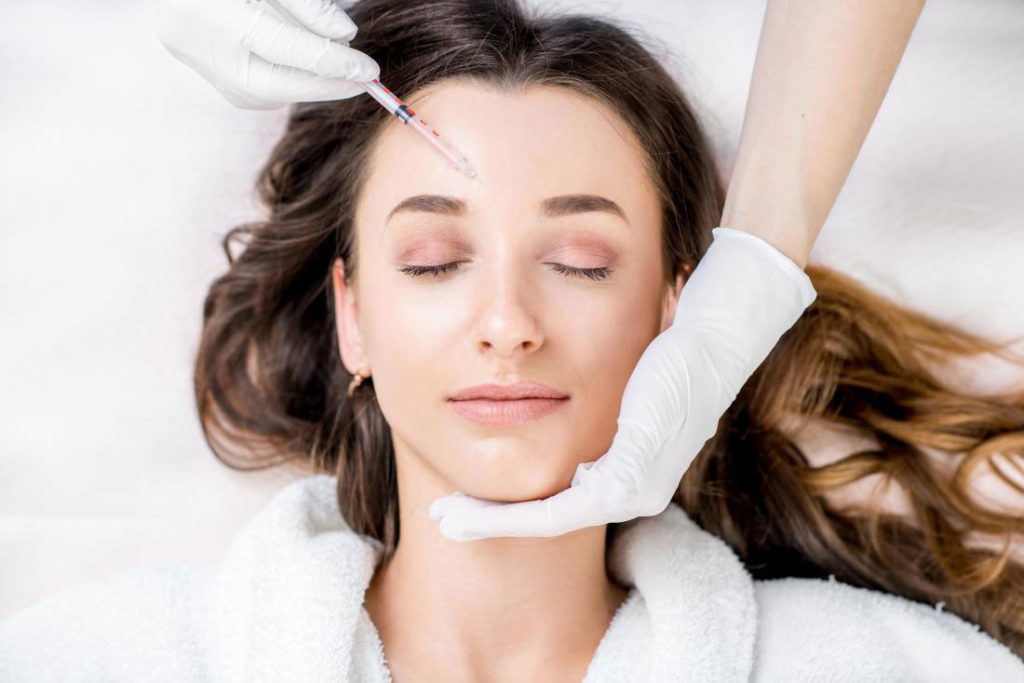 Botox
Botox is a household name as common and as recognizable as McDonald's or Wal-Mart. Impressive, considering that Botox is a medical treatment, a category not often penetrated by public recognizability as thoroughly.
But as we begin to learn more about Botox and how it affects our bodies and addresses those unwanted wrinkles and fine lines on our face, other applications of the drugs are beginning to resurface.
Additionally, conditions treated by Botox before it became a pop-culture staple are gaining more traction as research and medical knowledge expand. What you might have missed along the way, though, is all the ways that Botox is used aside from cosmetic improvement.
So, to help fill in those blanks, we made an easy-to-read list for you.
1. Treating Crossed Eyes
Believe it or not, since the 1970s, Botox has been used to treat patients with a condition known as
strabismus, most identifiable by how it causes patients' eyes to become misaligned. There is some misunderstanding that strabismus is the condition behind the term "lazy eye," but the two phrases are actually medically unrelated.
Strabismus is different from a lazy eye in that the eyes themselves have no problem seeing, while a lazy eye, also known as amblyopia, does. Botox is one of the most common treatments for this condition since it excels at stopping unwanted muscle movement in the eyes and throughout the entire body.
In fact, this method of treatment is so reliable and safe that it is even
used in small children. The effects begin to develop between one and two days after the injection. It is performed under general anesthetic in most cases and lasts between three and four months.
2. Reducing Anxiety
You read that right. A
study published in 2021 has shown preliminary and early evidence that Botox injections have some correlation to reduced instances of anxiety in individuals. But how would a drug that is used to stop muscle movement help reduce anxiety?
Well, it's actually pretty simple. There's something in medicine known as the
facial feedback hypothesis. This hypothesis suggests that the facial expressions an individual makes will directly influence their actual emotional state.
Charles Darwin was actually the first to study the effect of facial expressions on our psyches. Darwin suggested, and has since been proven right numerous times, that facial expressions are biologically innate, not culturally learned.
Pushing Darwin's original hypothesis further, the facial feedback hypothesis has been studied extensively and has been shown to excel at "modulating" or preventing the intensification of feelings. It has been particularly useful in instances of child education and even endurance performances.
Instead of teaching someone to control their facial expressions to help prevent the reinforcement of emotions like stress or fear, Botox stops the muscles from contracting entirely.
There's also the
James-Lange Theory of Emotion, which suggests that emotions are directly caused by your body's physical responses like facial expressions, which would explain Botox's success in stopping anxiety before the facial expressions can be made, but that is another story entirely.
3. Correcting an Overactive Bladder
We all know someone who strategically plans their entire lives around the proximity to a bathroom. Maybe it's a parent, grandparents, aunt or uncle. Luckily for them, physicians at the Center for Women's Pelvic Health at UCLA, along with others, worked on studying the treatment of an overactive bladder with Botox.
UCLA now
states that "Botox injection into the bladder is a well-established treatment for overactive bladder and urgency incontinence, including urgency incontinence associated with neurological disease."
The treatment lasts anywhere between six and 12 months for the average patient, at which point a repeat procedure will be needed. Since the procedure can be performed in about 30 minutes, it is usually a pretty simple process to maintain. Botox was officially approved to address overactive bladders in 2013, but it was being used and trialed for that purpose long before that.
4. Treating Acne

Recently, a group of medical professionals put together a list of
six studies that proved Botox (and other similar injections) could be used to successfully treat a specific type of acne known as acne vulgaris, the scientific name for the common acne that plagues more than
3 million people per year.
The science behind the treatment is pretty interesting. One of the major causes of acne is the production of oil. One of the key substances behind the production of oil in our skin is a chemical known as acetylcholine. Botox blocks this material from partaking in the oil production process.
Some
early information also points to Botox's potential anti-inflammatory properties. Inflammation is another one of the leading causes of common acne. Studies and data are still being developed, but for now, the treatment of acne seems to be a happy side effect of its other uses.
5. Stopping Unwanted Neck Movement
Cervical dystonia, also known as spasmodic torticollis, is a medical condition that causes the person diagnosed to twist or turn their head involuntarily. It is caused by a mistrigger by the brain, which sends incorrect signals to the muscles in the neck, triggering a muscle contraction.
In a
clinical study, Botox was able to provide improvement to people with this condition as quickly as two weeks after injection, although the best results developed within six weeks of the initial treatment. The mechanisms behind this treatment are the same as its cosmetic use: stop the brain from being able to communicate with the muscle entirely.
6. Prevents Unwanted Sweating
Hyperhidrosis, or the overproduction of sweat, is a rare condition that affects only 1% of the population. The signals that are needed to tell the sweat glands to produce sweat are triggered from the brain, but if you use Botox to stop that connection, then you can stop the production of sweat altogether.
But we aren't just talking in the underarms here. Take
Alexa, a patient from the Children's Hospital of Philadelphia, for example, who suffered from excessively sweaty hands. The conditions played a huge factor into her life. Here is an excerpt from her story:
"For Alexa, that meant awkward explanations whenever she needed to shake or hold hands with someone — as she often did during theater performances. It meant messy written papers and tests when her wet hands smeared her writing and wrinkled the paper. It meant apologies to her piano teacher for leaving puddles on the piano keys."
Botox is a solution for people like Alexa, especially those who would prefer to avoid surgeries, particularly in areas as high risk as the hands.
7. Preventing Hair Loss
A common form of hair loss is known as androgenetic alopecia. In a
clinical study, eight out of ten total patients had a good to excellent response to their assessment. At the end of a 24-week period, that number dropped only to 7 out of ten people. Two of the remaining three showed a fair response.
The conclusion was that botulinum toxin (Botox or similar treatments) was found to be a safe and effective therapy for the management of androgenetic alopecia in this pilot study. While this is only preliminary research, it shows promising options for people suffering from certain forms of hair loss.
8. Decrease Excess Salivation
Similar to hyperhidrosis, the overproduction of sweat, a different condition known as hypersalivation, exists, which is the overproduction of, you guessed it, saliva. Instead of targeting sweat glands, though, in this treatment, Botox will specifically look to address salivary glands in the mouth. The University of Iowa Health Care details this process in
two cases they handled through the use of Botox injections.
Want to Learn More?
If you are interested in getting more information about how Botox can help you, give our office a call at (916) 333-4906. You can also fill out our
online contact form to have a member of our team reach out to you at a more convenient time.
 Botox is a household name as common and as recognizable as McDonald's or Wal-Mart. Impressive, considering that Botox is a medical treatment, a category not often penetrated by public recognizability as thoroughly.
But as we begin to learn more about Botox and how it affects our bodies and addresses those unwanted wrinkles and fine lines on our face, other applications of the drugs are beginning to resurface.
Additionally, conditions treated by Botox before it became a pop-culture staple are gaining more traction as research and medical knowledge expand. What you might have missed along the way, though, is all the ways that Botox is used aside from cosmetic improvement.
So, to help fill in those blanks, we made an easy-to-read list for you.
Botox is a household name as common and as recognizable as McDonald's or Wal-Mart. Impressive, considering that Botox is a medical treatment, a category not often penetrated by public recognizability as thoroughly.
But as we begin to learn more about Botox and how it affects our bodies and addresses those unwanted wrinkles and fine lines on our face, other applications of the drugs are beginning to resurface.
Additionally, conditions treated by Botox before it became a pop-culture staple are gaining more traction as research and medical knowledge expand. What you might have missed along the way, though, is all the ways that Botox is used aside from cosmetic improvement.
So, to help fill in those blanks, we made an easy-to-read list for you.
 Recently, a group of medical professionals put together a list of six studies that proved Botox (and other similar injections) could be used to successfully treat a specific type of acne known as acne vulgaris, the scientific name for the common acne that plagues more than 3 million people per year.
The science behind the treatment is pretty interesting. One of the major causes of acne is the production of oil. One of the key substances behind the production of oil in our skin is a chemical known as acetylcholine. Botox blocks this material from partaking in the oil production process.
Some early information also points to Botox's potential anti-inflammatory properties. Inflammation is another one of the leading causes of common acne. Studies and data are still being developed, but for now, the treatment of acne seems to be a happy side effect of its other uses.
Recently, a group of medical professionals put together a list of six studies that proved Botox (and other similar injections) could be used to successfully treat a specific type of acne known as acne vulgaris, the scientific name for the common acne that plagues more than 3 million people per year.
The science behind the treatment is pretty interesting. One of the major causes of acne is the production of oil. One of the key substances behind the production of oil in our skin is a chemical known as acetylcholine. Botox blocks this material from partaking in the oil production process.
Some early information also points to Botox's potential anti-inflammatory properties. Inflammation is another one of the leading causes of common acne. Studies and data are still being developed, but for now, the treatment of acne seems to be a happy side effect of its other uses.
